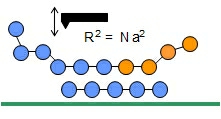aktuelle Projekte
SFB/Transregio 102: Teilprojekt A1 Effekte der topologischen Einschränkungen in Polymerschmelzen auf Kristal-lisation und Strukturbildung
Zusammenfassung:
Kristallisation aus der verschlauften Schmelze unterliegt Einschränkun-gen durch die gegebene topologische Struktur und Dynamik derselben. In diesem Projekt sollen die Konsequenzen dieser Einschränkungen auf die Kristallisation und die teilkristalline Morpho-logie von Polymeren untersucht werden. Für eine Reihe von Modellmaterialien soll der Prozess der Strukturbildung und die resultierenden teilkristallinen Materialien mit Hilfe der folgenden Methoden systematisch untersucht werden: Röntgenkleinwinkelstreuung und Spindiffusions-NMR (Strukturbildung), Optische Mikroskopie (Kristallisationskinetik), DSC (Thermodynamik), Rheologie und Festkörper-NMR (molekulare Dynamik). Besonderes Gewicht kommt der Unter-suchung der Eigenschaften der amorphen Phase zu, da hier die durch die topologischen Ein-schränkungen verursachten Effekte am deutlichsten zum Ausdruck kommen sollten.
SFB/Transregio 102: Teilprojekt B3 Substratinduzierte molekulare Ordnung und Keimbildung in dünnen Filmen aus teilkristallinen Polymeren.
Zusammenfassung:
Gegenstand des Projekts ist die Erforschung der Grenzfläche zwischen einem kristallinen Festkörper und der Schmelze eines kristallisationsfähigen Polymers. Diese Art von Grenzflächen spielt eine entscheidende Rolle bei der heterogenen Keimbildung und im Prozess des Kristallwachstums. Als Modellsystem sollen dünne Filme aus kristallinen Polyme-ren auf Substraten untersucht werden, die epitaktisches Wachstum auslösen. Die Experimente mit Hilfe von AFM und Röntgenstreuung sollen sowohl in der Schmelze, während als auch nach der vollständig erfolgten Kristallisation durchgeführt werden. Die Kombination der experimentel-len Methoden erlaubt Zugang zu komplementären Informationen über Morphologie auf meso-skopischer Skala und Kristallstruktur auf molekularer Skala.
DFG Projekt - Synthese und Bindungsdynamik von Pseudo-Blockcopolymeren
Zusammenfassung
The project deals with the synthesis, structure formation and mechanical properties of microphase separated pseudo block copolymers. In contrast to ‘normal’ block copolymers in which immiscible blocks are connected via a covalent bond, we will study systems in which the blocks are connected via hydrogen bonds. Such self associating polymers are interesting as materials with self healing properties. Several polymer systems with different glass transition temperatures, miscibility and molecular weight will be investigated. Dynamic mechanical measurements and small angle x-ray scattering will be used to gain information on the mobility of individual polymer chains and the nature of the hydrogen-bonds acting as molecular “glue” between them.
DFG Project in SPP 1355 „Elementary Processes of Organic Photovoltaics”
Organic Solar Cells from Optimized Self-Assembling Block Copolymers with Controlled Nanoscale Morphology
Zusammenfassung
The project is a joint effort between Macromolecular Chemistry, Physical Chemistry and Experimental Physics in which three groups bring in complementary expertise from different fields such as synthesis, morphological studies, and device physics. The aim of the project is to design, synthesize, and study fully functionalised self-assembling block copolymers to realize and optimize nanostructured bulk heterojunction solar cells. Block copolymers guarantee desired stable nanoscale morphologies throughout the bulk, keeping the domain size in the same range as exciton diffusion lengths. Novel block copolymers will be synthesized designed to optimize the efficiency of photoinduced charge separation and charge transport in a system with a well controlled stable nanostructure based on microphase separation and crystallization. Structure formation processes will be studied in detail in order to gain the necessary understanding for a rational design of suitable processing steps for film formation. The electro-optical properties of the resulting materials will be investigated with the aim to understand the physics of solar cell devices based on the materials developed within the project.





